The number of online shoppers is growing year by year. According to Statista, the ecommerce industry swiftly approaches 1 trillion USD in total revenue by 2024 and keeps growing steadily.
Accordingly, ecommerce platforms can offer new opportunities and set new sales standards in the industry without worrying about major losses. Thanks to marketplaces, anyone can sell and buy almost everything without leaving their home.
In this article, we will look at the best online marketplaces in Australia, such as eBay, Amazon, Catch, TheMarket, Kogan, MyDeal, Ozsale, The Iconic, Trade Me, and Bunnings Marketplace.
Our team reviewed them regarding the monetization strategy used, markets that are present, and features that are offered to customers. Let’s get started.
Benefits for sellers and buyers
As vendors are people who publish and intend to sell their goods, there are three main advantages online marketplaces can offer them.
- Low initial investment. You can create your ecommerce store and maintain and optimize it with minimal expenses, as platforms usually provide all the functionality needed.
- Access to a larger audience. Online marketplaces often have a significant number of active users and customers. This provides sellers with immediate access to a large and diverse audience, which can be challenging to reach through other means.
- Simplified payment processing. Marketplaces often handle payment processing on behalf of sellers, making it easier for them to accept various payment methods, handle international transactions, and reduce the risk of fraud.
- Data and analytics. Sellers can access valuable data and analytics on customer behavior, sales trends, and market insights. This information can be used to optimize pricing, inventory management, and product offerings.
Your buyers also benefit from using a robust marketplace. Thus, for them, the benefits are as follows:
- Rich products and services catalog. Buyers can find desired items in minutes, as they are often offered by different vendors, regardless of the geographical location.
- Convenience in use. Ecommerce platforms always focus on positive user experience, providing convenient interfaces, functionality, and handy features.
- Customer service support. Many online marketplaces offer customer service support to address buyer inquiries, concerns, and disputes, providing an additional layer of security and assistance.
- Competitive pricing. The competitive nature of online marketplaces often leads to competitive pricing, as sellers strive to offer the best deals to attract buyers. Buyers can compare prices and find the most cost-effective options.
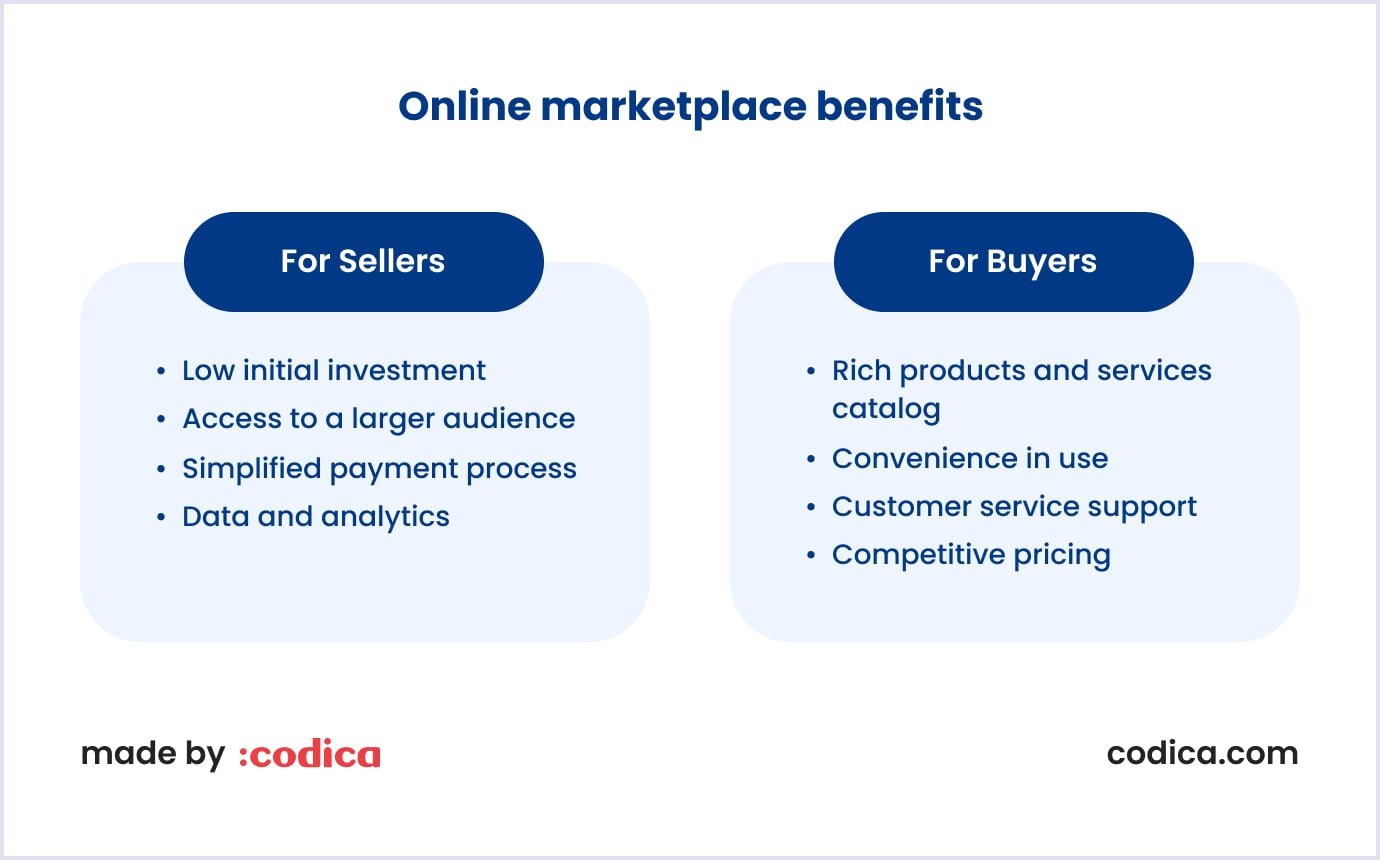
Top biggest online marketplaces in Australia overview
Right after some theory, let’s get back to the best online selling platforms Australia can offer. All of them are recognizable brands that attract thousands of visitors in Australia. Moreover, they also move beyond the continent, expanding their reach and success in international markets.
1. eBay
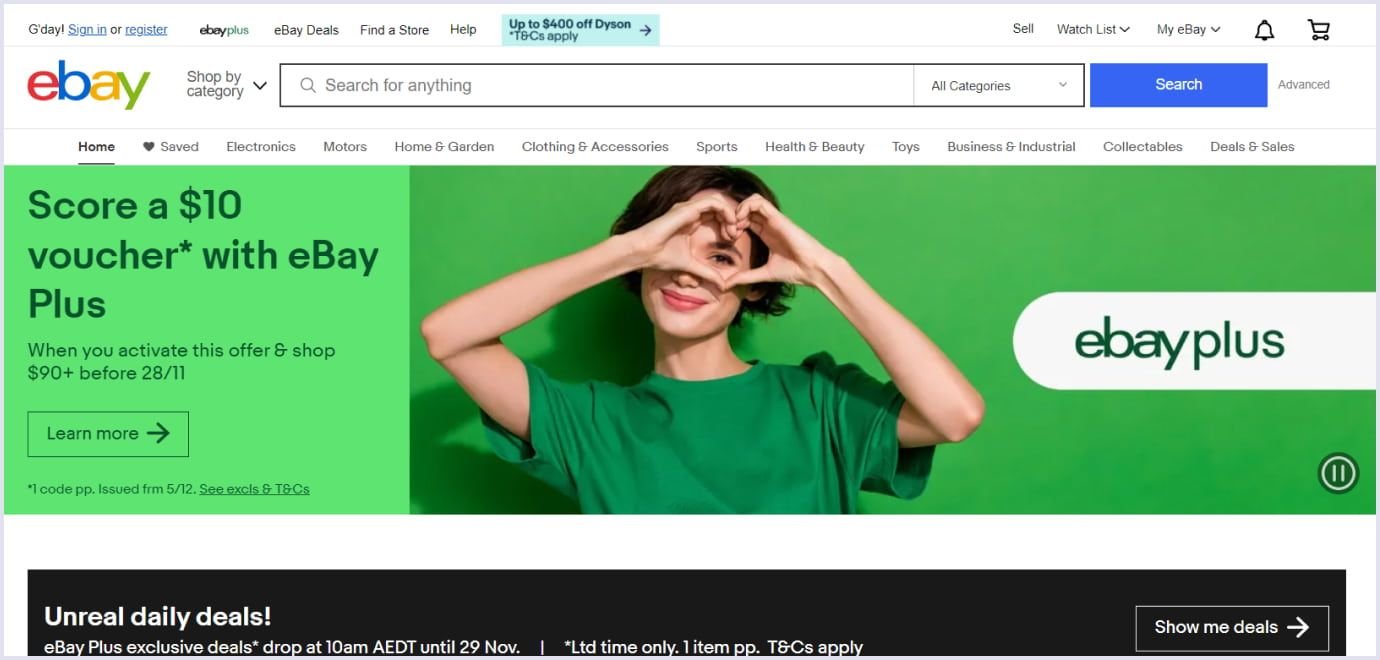
Source: eBay
Pierre Omidyar incorporated eBay in 1995 as a B2C and B2B platform. The online shop was founded as a part of a personal website. Today, eBay is one of the most powerful marketplaces, selling lots of products and services.
Thanks to the auction-centric approach, Australian eBay regularly stays among the top marketplaces on the continent. According to Similarweb, ebay.com.au had 38.7 million visits in October 2024. It currently resides in second place in the ecommerce and shopping marketplace category in Australia.
Fast facts
- 38.7 million visits in the last month;
- $2.6 billion in revenue in Q3 2024;
- 2.1 billion live listings.
Monetization strategy and business model
- Final value fees. eBay charges sellers a final value fee, which is a percentage of the total sale amount, including shipping and handling. This fee varies by category and seller type. For instance, private sellers in the UK are charged a final value fee of 12.8% plus a fixed charge of approximately $0.38 USD per order.
- Listing fees. Sellers receive a monthly allocation of free listings. For example, private sellers in the UK are entitled to 300 free listings per month. Additional listings beyond this limit cost approximately $0.44 USD each.
- Subscription options. eBay offers subscription plans, such as eBay Shops, which provide benefits like increased free listings and advanced selling tools. The subscription fees and features depend on the plan selected.
2. Amazon
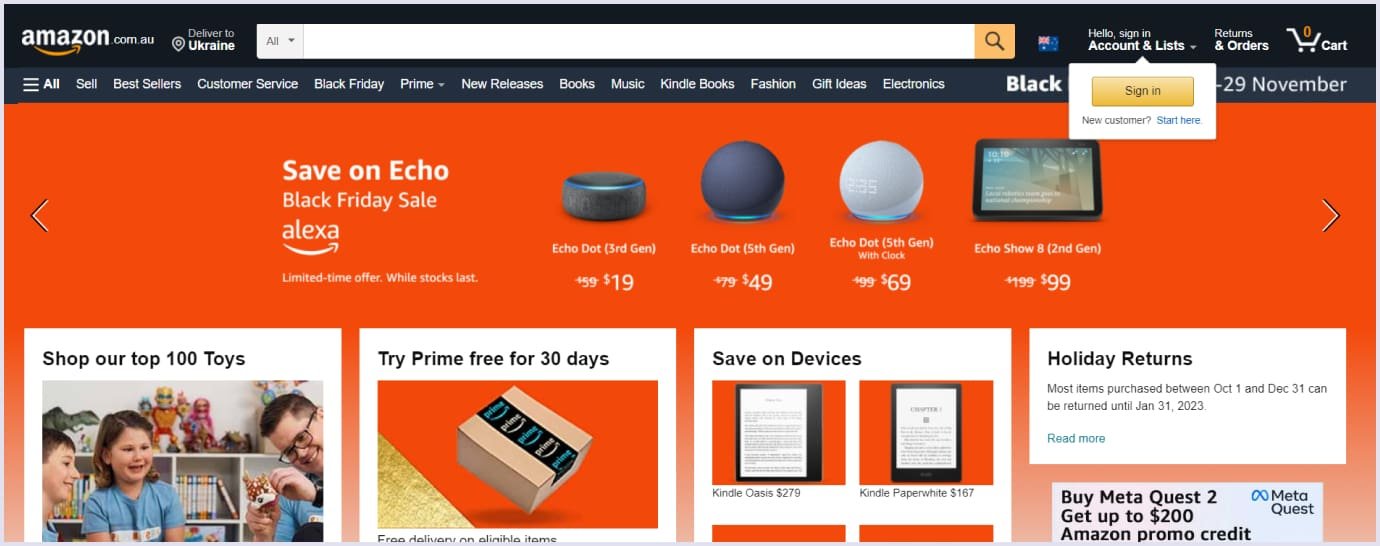
Source: Amazon
Amazon is one of the largest global marketplaces. Although Amazon aimed initially to sell books, now, it has an endless variety of items, from electronic devices to food, jewelry, clothes, and almost anything you can think of.
Today, Amazon has separate sites for 16 countries. Among them, you can see the US, Canada, Japan, the UK, New Zealand, Australia, and others.
Speaking of popularity, the formula is simple: a strong brand and excellent reputation. In this regard, we can recall Jeff Bezos’ quote:
“A brand for a company is like a reputation for a person. You earn a reputation by trying to do hard things well.”
Thanks to its reputation and years of experience, Amazon constantly increases its users' database and boasts other fascinating metrics. Let’s get in more detail with numbers.
Amazon categorizes its operations into three primary segments: North America, International, and AWS (Amazon Web Services).
The "North America" and "International" segments pertain to the geographical aspects of Amazon's retail activities, encompassing retail sales, subscriptions, and export transactions.
On the other hand, AWS offers cloud services to a wide spectrum of clients, including businesses, government entities, and educational institutions, enabling them to manage data and distribute content.
Amazon's chief revenue source is retail, with both online and brick-and-mortar stores contributing significantly.
Fast facts
- 310+ million active users;
- 3.25 billion monthly visits;
- $158.9 billion in Q3 2024;
- 350+ million sale items.
Monetization strategy and business model
Amazon employs a multifaceted monetization strategy and business model, encompassing various revenue streams.
Monetization strategies
- Retail sales. Amazon sells a vast array of products directly to consumers through its online platform, generating significant revenue from these sales.
- Third-party seller services. The company offers a marketplace for third-party sellers, charging fees for services such as listing products, fulfillment, and other seller tools.
- Subscription services. Amazon provides subscription-based offerings like Amazon Prime, which includes benefits such as free shipping, streaming services, and exclusive deals.
- Advertising services. Through its advertising platform, Amazon enables brands to promote their products on its site, generating substantial advertising revenue.
- Amazon Web Services (AWS). AWS offers cloud computing services to businesses and individuals, contributing a significant portion to Amazon’s overall revenue.
Business model
Amazon operates using both business-to-consumer (B2C) and business-to-business (B2B) models.
- B2C. Through its e-commerce platform, Amazon sells products directly to consumers, offering a wide range of goods and services.
- B2B. Amazon Business caters to the procurement needs of businesses, providing bulk purchasing options, business-only pricing, and other enterprise solutions.
You may also like: How Much Does It Cost to Build a Website Like Amazon?
3. Kogan
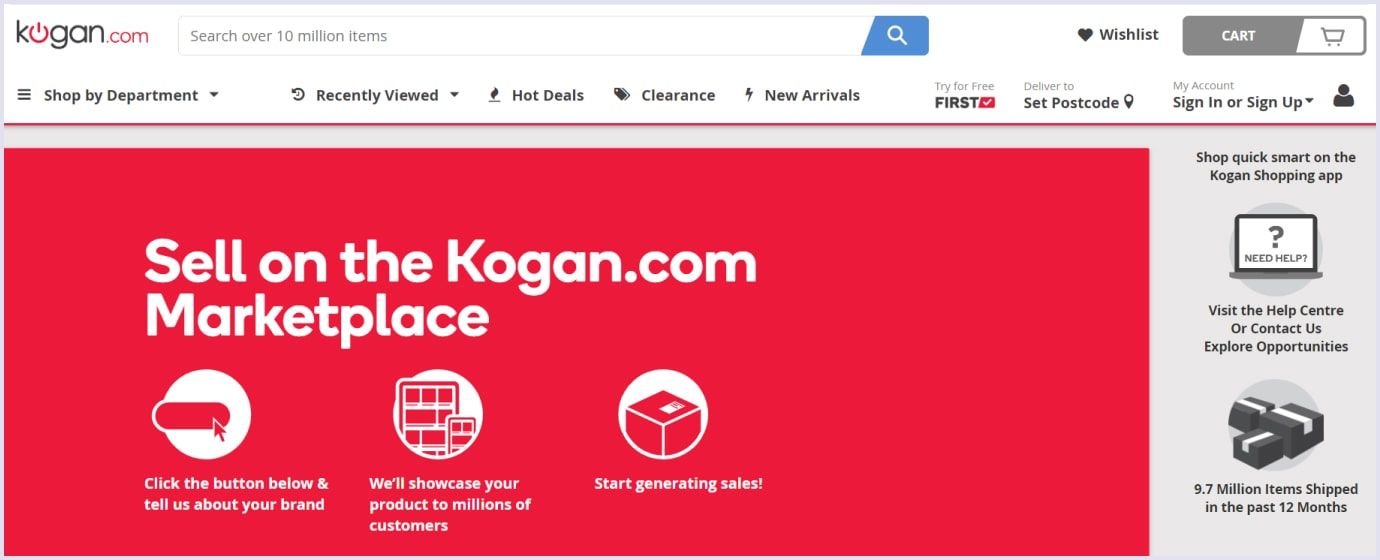
Source: Kogan
Kogan is another popular online marketplace in Australia. It is one of the biggest daily deals solutions and offers a wide selection of things across all categories. The Kogan marketplace is a house to thousands of brands. For sellers, it provides many marketing tools, including email campaigns and seasonal deals like Black Friday, etc.
With about 5+ million visits in October 2024 and $129.2 million AUD gross sales in the first half of 2024, Kogan is not a marketplace you can ignore.
Fast facts
- 2.6+ million active customers;
- 5+ million monthly visits in October 2024;
- 15+ product categories;
- Over 2,000 sellers on the marketplace.
Monetization strategy and business model
Kogan Marketplace primarily operates on a commission-based model, where sellers are charged a commission fee for each sale. The specific commission rate is determined during the vendor’s registration process.
In addition to the commission, sellers incur a Merchant Payment Processing Fee of 20 cents plus 1.39% per order.
Regarding the platform’s structure, Kogan Marketplace functions as a business-to-consumer (B2C) platform, connecting businesses directly with consumers.
You may also like: How to Create a Multi-Vendor Marketplace Website
4. MyDeal
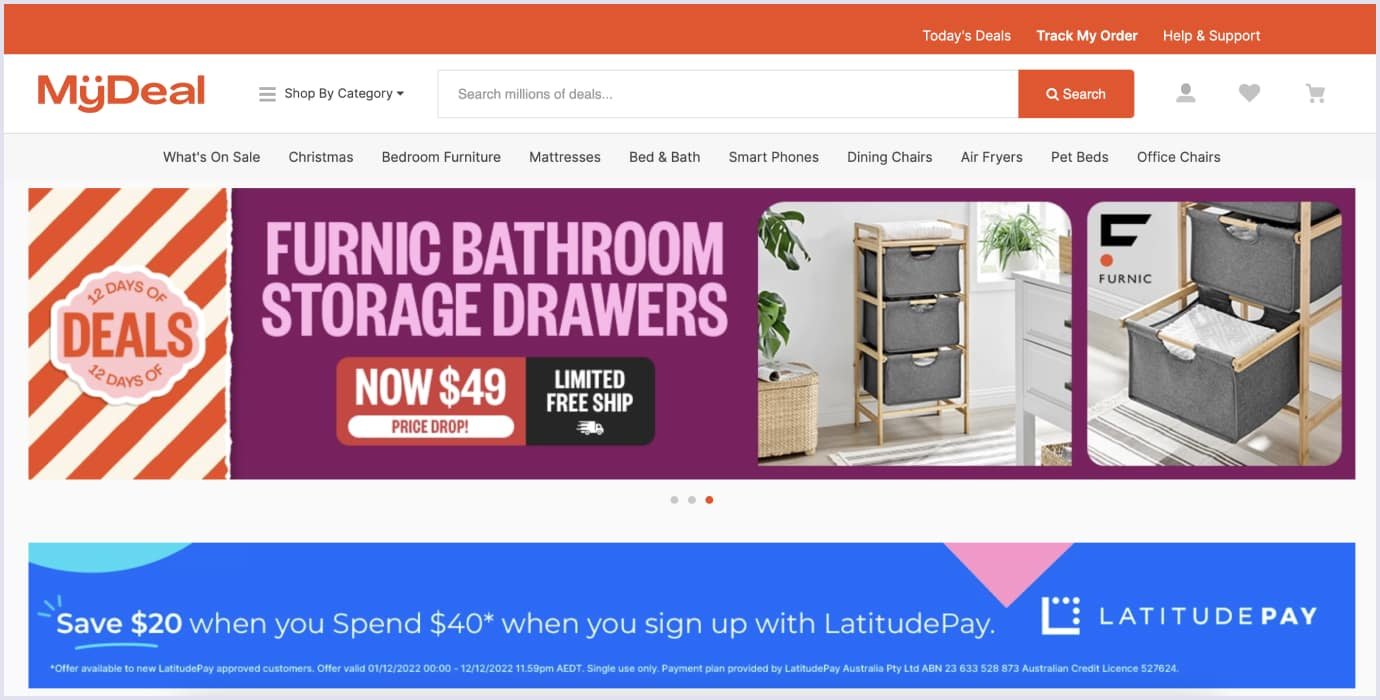
Source: MyDeal
A firm favorite among Australians, MyDeal is a rapidly growing online marketplace. Mainly, MyDeal is focused on selling bulkier products such as furniture. Although it also sells other products, such as pet products and fitness equipment.
Interestingly, the marketplace provides small business loans to suppliers needing financial assistance. They may need this money for business expansion or to access rapid funding.
The sellers on the MyDeal site are responsible for the order fulfillment process and all needed logistics.
Fast facts
- ~2.3 million monthly visits;
- 1+ million active customers;
- Over 6 million products listed.
Monetization strategy and business model
MyDeal’s monetization strategy primarily involves charging sellers a commission fee for each item sold, with rates varying by product category. Additionally, sellers are subject to a monthly subscription fee of AUD $49.90 (excluding taxes).
MyDeal is primarily a B2C online marketplace, connecting businesses directly with individual consumers.
5. Catch
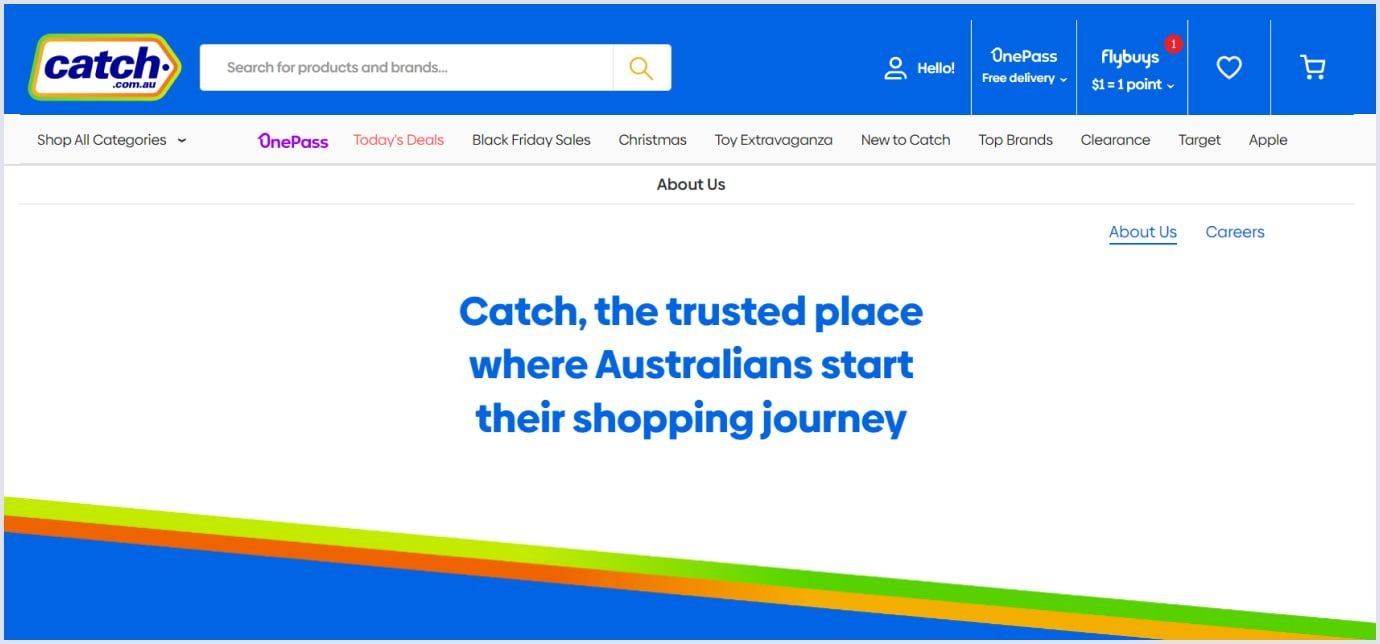
Source: Catch
Another marketplace Australia has to offer, Catch was launched in 2007. It offers over 2 million products, including furniture, food, clothing, groceries, sporting goods, and more.
With this Amazon alternative Australia has a huge marketplace with the main focus on making online shopping available for regular Australians. For now, Catch can boast over 6.8 million visits in October 2024.
This one of the largest daily deals solutions stands out with its commitment to assisting new vendors. As a merchant, you’ll get dedicated support. So, the sellers on Catch are able to optimize their goods listings and promote their brands. In turn, the customers also receive a great shopping experience.
By the way, Catch is one of the simplest and convenient marketplaces to use on mobile. Desktops drive 30.92% of visits, while 67.48% of visitors come from mobile devices.
Fast facts
- 3+ million active customers;
- 6.8 million monthly website visits in October 2024;
- 16 product categories;
- Over 2.5 million items for sale.
Monetization strategy and business model
- Subscription fee: AUD $49.99 per month (inclusive of GST);
- Listing fee: none;
- Commission fee: varies by product category.
This digital market is based on a horizontal platform. It is a B2C marketplace for buying and selling goods.
Read also: How to Build an Online Marketplace: 17 Tips for Aspiring Entrepreneurs
6. The Warehouse
Starting with the overview, The Warehouse is a marketplace based in New Zealand. It operates as a platform facilitating various stores to showcase and sell their products in a unified location.
This unique setup offers an exceptional opportunity for New Zealand and Australian residents to conveniently browse and purchase items from a multitude of stores all in one place.
It functions as a local shopping mall, albeit one that boasts an extensive selection of over 1000 stores, all prepared to deliver virtually any item you may require to your doorstep.
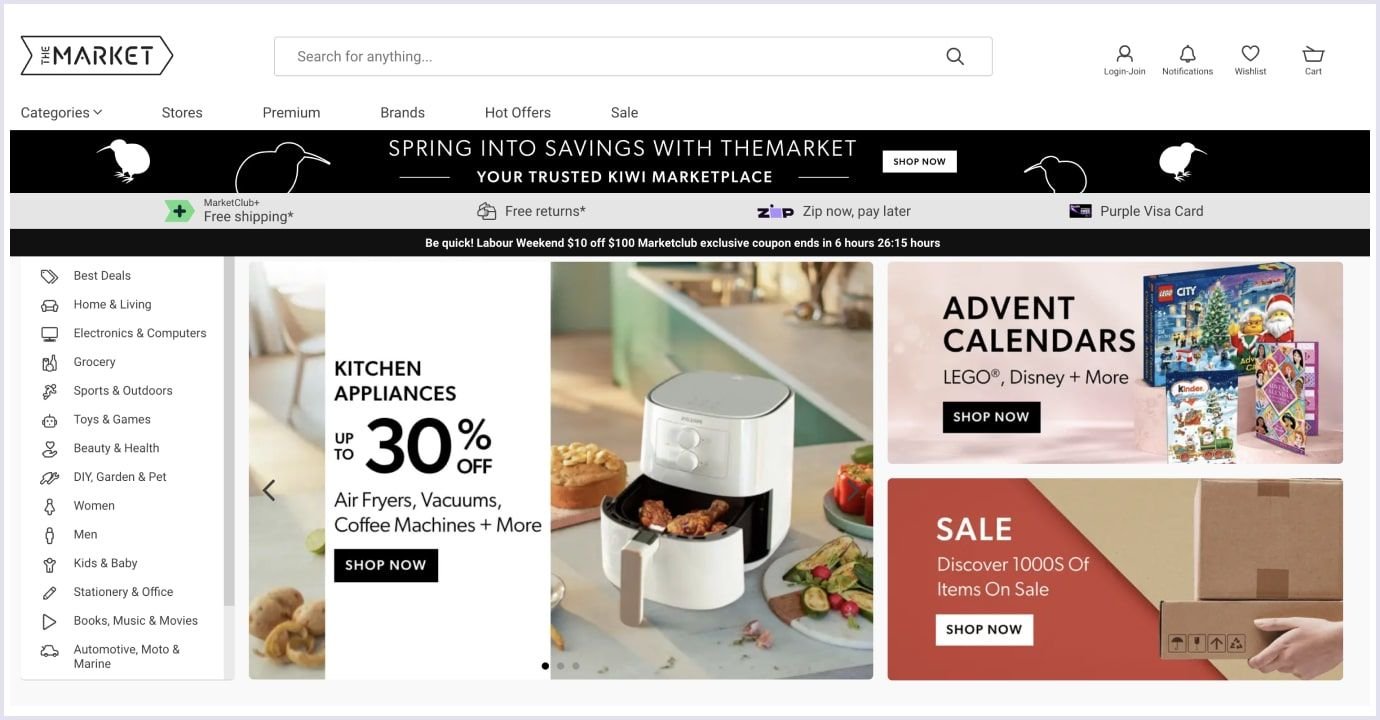
Source: The Warehouse
When individuals make purchases on The Warehouse, they are essentially placing orders with the specific store that lists the products for sale. Consequently, the products are sourced and dispatched directly from the respective stores to the customers. Vital delivery information, such as the origin of the shipment, is prominently displayed on each product listing for clarity and transparency.
Fast facts
- Founded in 2019;
- Over 1 million active users;
- More than 1000 sellers;
- Approximately 1.5 million monthly visits.
Monetization strategy and business model
- Retail sales;
- Private label products;
- Loyalty programs.
The Warehouse Group combines traditional stores with a growing online presence, generating revenue through direct product sales, private-label goods, and value-added services. Its discontinued marketplace, TheMarket.com, is now integrated into the main platform, offering a broader product range and seamless transactions.
The MarketClub loyalty program drives subscription revenue with exclusive discounts and free shipping. Fulfillment services handle inventory, packing, and delivery through centralized centers, while The Warehouse team manages customer service, disputes, and returns. This approach benefits both merchants and customers by streamlining operations and enhancing the shopping experience.
7. Ozsale
It is one of the biggest online marketplaces in Australia at present. This Australian marketplace offers a wide range of products from various brands, and it's known for its flash sales and limited-time offers, often featuring significant discounts on popular brands and products.
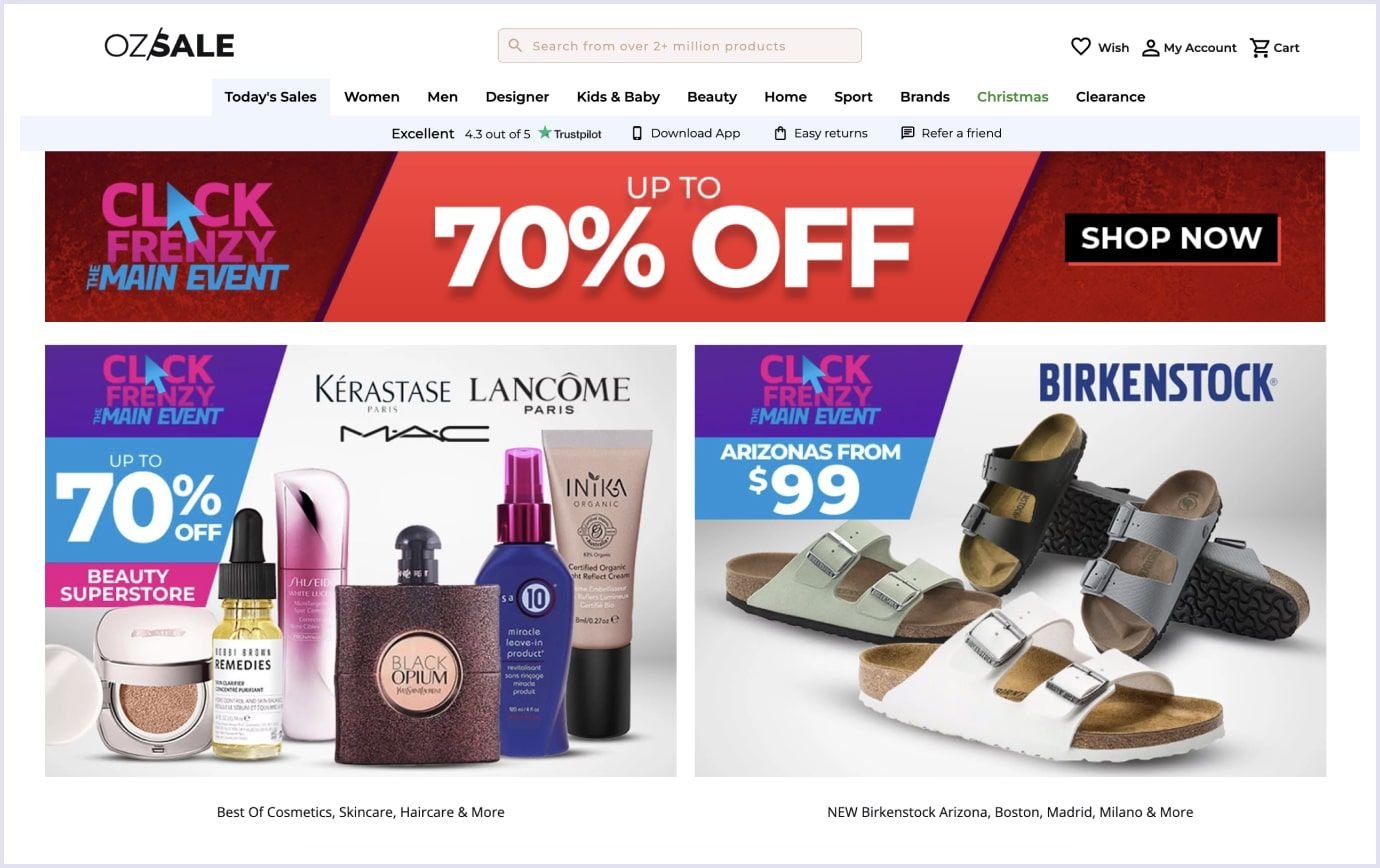
Source: Ozsale
Fast facts
- Founded in 2007;
- Over 2 million products shipped annually;
- Approximately 3.8 million unique monthly visitors;
- Over 1,000 brands offered.
Monetization strategy and business model
In terms of income and monetization, Ozsale has several revenue streams.
- Commission fee. Ozsale generates revenue by allowing people to become sellers and advertise their products on the platform. Customers make purchases through the platform, and Ozsale earns a profit on the sale of these products.
- Marketing and advertising. Ozsale may partner with brands and retailers to promote their products through its platform. Brands can pay for prominent placement, featured listings, or advertising space to reach Ozsale's customer base. These marketing and advertising partnerships can be a source of revenue.
Regarding the business model, Ozsale is a flash sales platform that offers exclusive deals to its members. The company partners with brands to offer discounts of up to 75% on products.
8. Bunnings Marketplace
Bunnings holds the position of being the leading retailer of home and lifestyle products for both consumer and commercial clientele in Australia and New Zealand. They serve as a significant supplier to project builders, commercial tradespeople, and the housing industry.

Source: Bunnings Marketplace
In 2019, Bunnings Australia marketplace added what we are looking at today to their platform. With the introduction of the Marketplace section, Bunnings became a place where different trusted sellers present their goods and grow an online store.
Fast facts
- Founded in 1994;
- 32.9 million visits in the last month;
- Over 300 stores in Australia and New Zealand;
- Over 40,000 products available online.
Monetization strategy and business model
Bunnings Marketplace operates as an extension of Bunnings Warehouse, focusing on a B2C model. It connects customers with third-party sellers offering a wide range of products online.
Monetization strategy
- Commission fees. Bunnings charges sellers a commission on each sale, with rates varying by product category.
- Setup and monthly fees. Sellers may incur setup fees based on the integration type and monthly fees that differ per merchant.
Business model
Bunnings Warehouse operates physical stores across Australia and New Zealand, offering a vast selection of home improvement products directly to consumers.
The Bunnings Marketplace platform allows third-party sellers to list products online, expanding the range available to customers beyond in-store offerings.
This integrated approach enables Bunnings to serve both in-store and online customers, providing a comprehensive shopping experience.
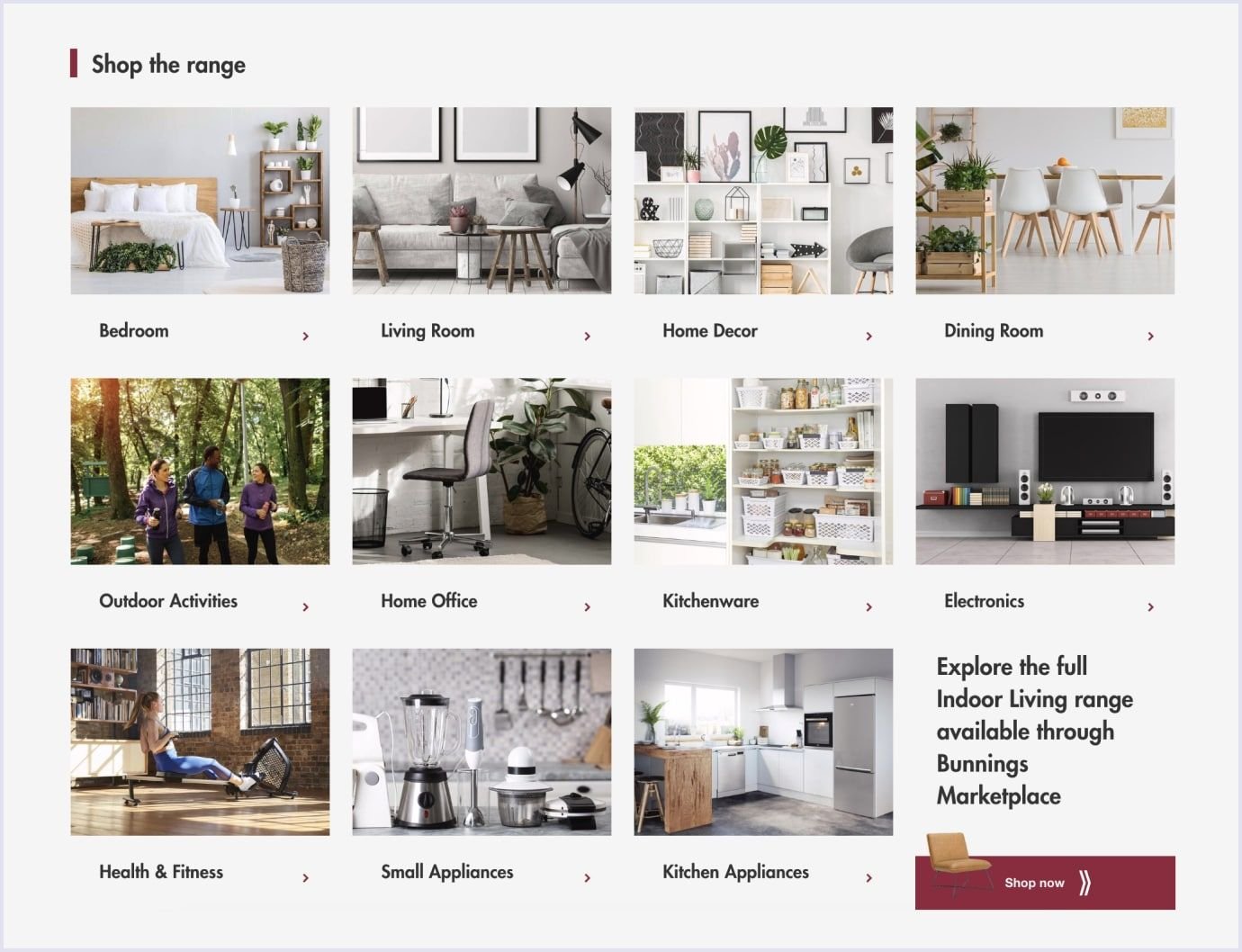
9. The Iconic
This marketplace from Sydney has quickly become the dominant force in Australia's "fashion and apparel" market. Offering a vast range of goods in the fashion, lifestyle, and sports sectors, The Iconic attracts a lot of visitors.
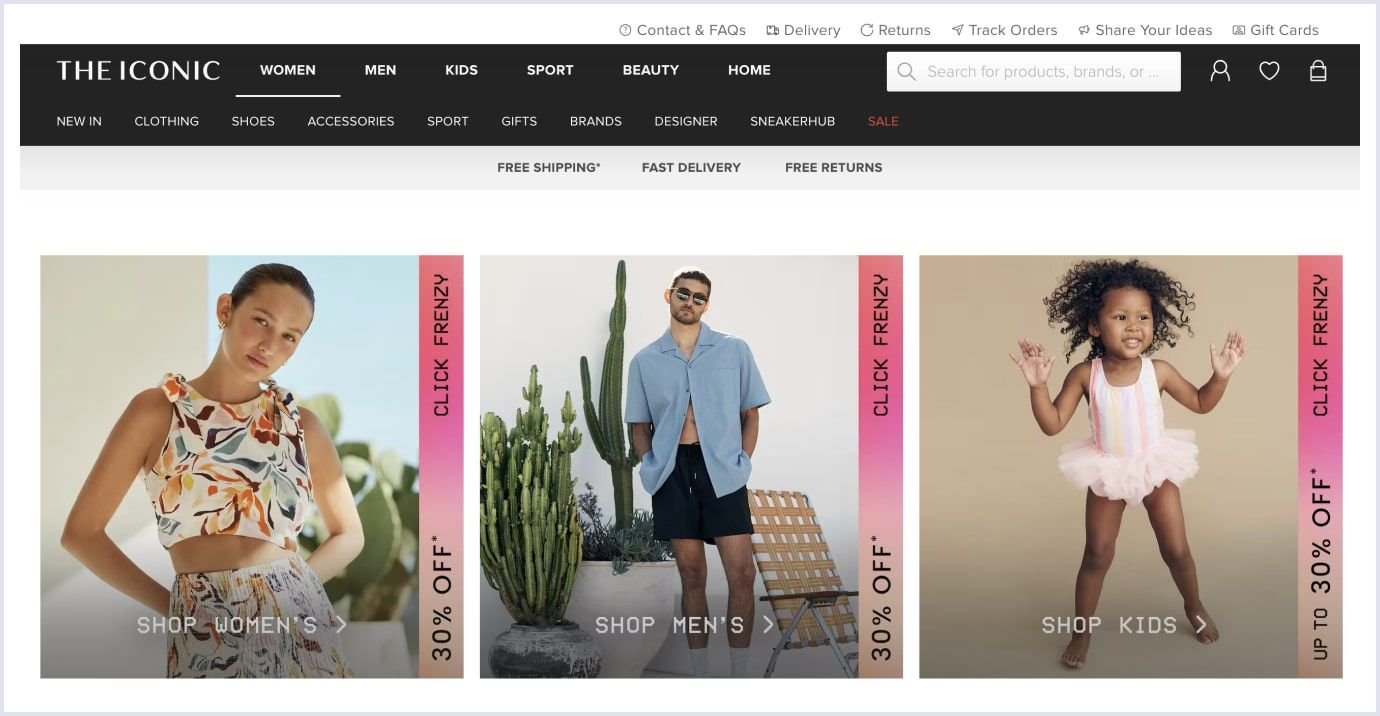
Source: The Iconic
The platform's fundamental tenet is empowerment, which extends to partners, employees, and consumers. As a result, selling your brand on The Iconic is an alluring opportunity.
Fast facts
- Founded in 2011;
- 12.1 million visits in the last month;
- Over 10 million active users;
- Over 1,000 brands.
Monetization strategy and business model
Monetization strategy
- Retail sales. The Iconic generates revenue by selling a diverse range of fashion, lifestyle, and sports products directly to consumers. It maintains inventory, allowing for prompt fulfillment of customer orders.
- Commission fees. The platform collaborates with third-party sellers, including various brands, enabling them to list and sell their products on The Iconic’s platform. In return, The Iconic charges these sellers a commission on each sale, contributing to its revenue stream.
- Sponsored listings and paid advertising. Through sponsored listings and advertising options, brands may increase their online presence. These brands raise their visibility to The Iconic's large consumer base by purchasing prominent placements, which increases The Iconic's advertising revenue.
Business model
The Iconic operates as a hybrid model, combining traditional retail with a marketplace approach:
Inventory management. The company holds inventory for products it sells directly, ensuring efficient order fulfillment and quality control.
Marketplace platform. The Iconic increases the range of products it offers without having to keep more inventory by letting independent vendors post their goods. This strategy allows the business to get commissions from sales made by these sellers while giving clients access to a wider range.
10. Trade Me
It is a reliable eBay substitute that Australia can take pride in, having been established in 1999 as an auction and classifieds platform. With more than 27 million monthly visitors, it is currently the fourth most popular website in the nation. Within the "Auctions" category, Trade Me holds the top position in New Zealand.
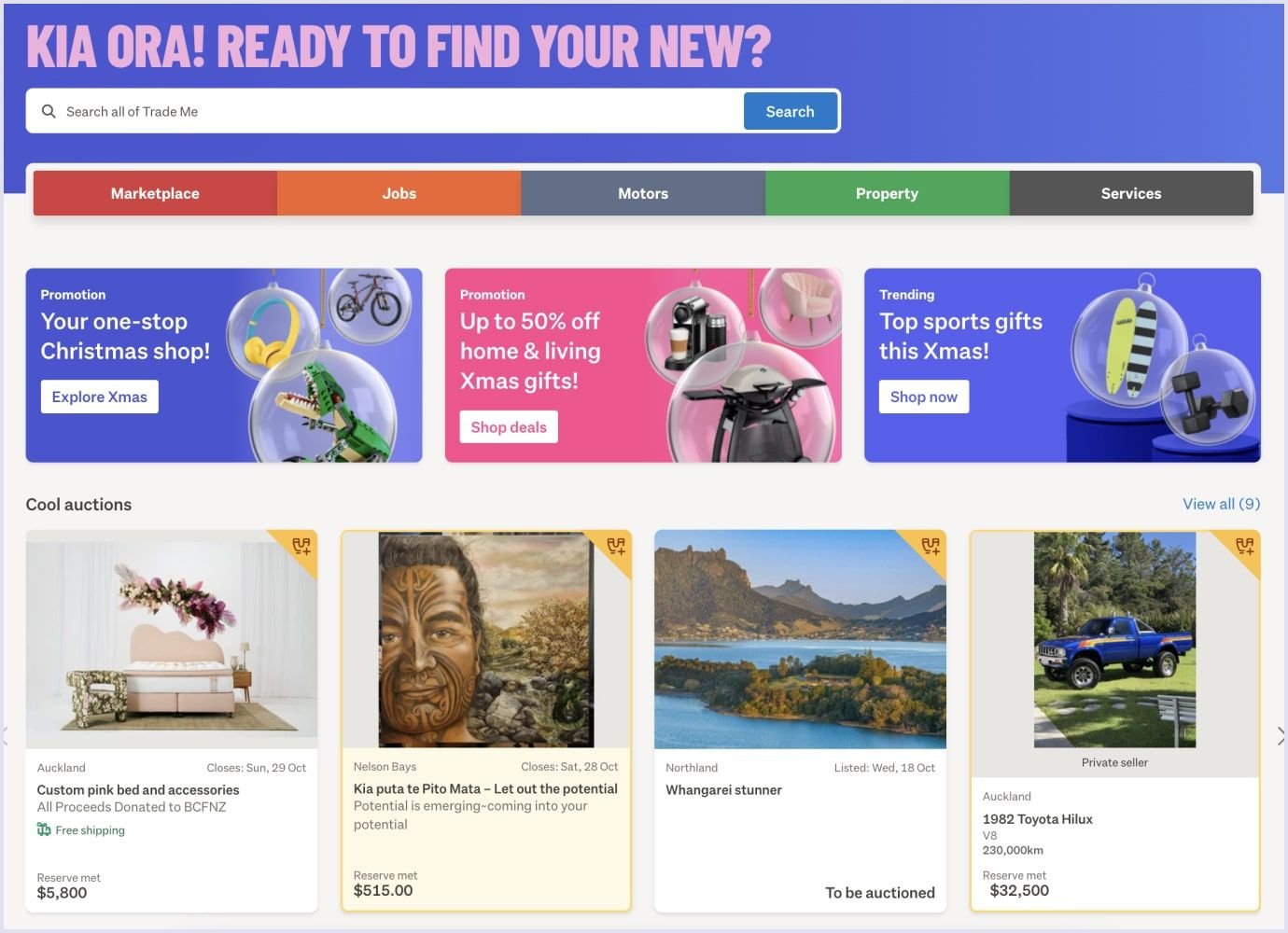
Source: Trade Me
Sellers can offer a large selection of products in a number of categories through the platform's marketplace section. The procedure of opening a business account is simple and only requires one form.
Once registered, sellers can start creating product listings. Furthermore, Trade Me provides valuable seller onboarding and optimization assistance for more effective listings.
Fast facts
- Founded in 1999;
- Headquartered in Wellington, New Zealand;
- Over 27 million online visits in October 2024;
- Over 10 million listings.
Monetization strategy and business model
Trade Me employs a multifaceted monetization strategy:
- Listing fees. Fees for listing goods or services vary depending on the category, time frame, and visibility settings for sellers.
- Success fees. When a transaction is successful, a commission is deducted from the sale price.
- Advertising revenue. Income is generated through on-site advertising placements.
- Subscription services. Users can purchase premium services at a regular cost.
In Australia, Trade Me and other comparable online marketplaces usually use a business-to-consumer (B2C) model to link buyers and sellers.
Although it is primarily a classified and auction website, Trade Me goes beyond it, offering other platforms as well. For instance, today, Trade Me has a dedicated horizontal marketplace, services platform, and classifieds page.

Comparison of 10 top online marketplaces
To decide which revenue model suits you best, you need to examine the pros and cons of each marketplace. Consider their fee structure, pay attention to the traffic, and learn their rules and regulations. Afterward, pick those models that will help you build a selling and competitive digital solution.
| Main features of top online platforms | |||||
| Number of users | Goods | Monthly membership fee | Listing fee | Commission | |
| eBay | 138+ million | Home decor and garden accessories, tech, fashion and shoes, jewelry and watches, collectibles and books | None | Free for the first 50 listings; subsequent listings start from $0.05 | From 3% to 10% per item |
| Amazon | 300+ million | Video games, toys, books, clothing, shoes and jewelry, cameras and electronics | $39.99 per month for a professional account | None | 0.99% per item sold |
| Kogan | 3+ million | Appliances, consumer electronics, homewares, hardware, toys, and more | $99 per year | $0.20 plus a 1.39% charge per item listed | Varies by product category |
| MyDeal | 1+ million | Furniture, fitness equipment, goods for home and garden | N/A | Varies by product category | Varies by product category |
| Catch | 3+ million | Electronics, kids and baby goods, clothing, cars and motorcycles, food and drinks | AUD 49.99 per month | Varies by product category | 10% to 25% per item sold, depending on category |
| The Warehouse | 1+ million | Home, decor, clothing, beauty, etc. | $5.99 per month | N/A | N/A |
| Ozsale | 1+ million | Fashion, beauty, home, and lifestyle products | None | N/A | Varies by agreement |
| Bunnings Marketplace | 300,000+ monthly visitors | Home improvement and outdoor products | None | N/A | Varies by product category |
| The Iconic | 10+ million active users | Fashion, sports, beauty, kidswear and homewares destinations. | None | N/A | Available upon request |
| Trade Me | 2+ million active monthly users | Various categories, similar to an online marketplace | None | Varies by product category and listing type | 7.9% of item price for individual sellers; 5.9% – 11.9% for business sellers |
Further reading: How Much Does It Cost to Build an Online Marketplace in 2025
Codica builds marketplaces that are loved in Australia
If you are looking for an experienced web development company, here we are. Codica’s team has accumulated vast experience creating websites for businesses in many countries.
We know the Australian market very well, as we have worked on projects for Australian businesses. Recently, we built two marketplaces for marine and caravan businesses from this country.
TradeRVs is an online platform for campers on the Australian continent. People use this caravan selling website to sell or buy motorhomes, caravans, and other recreational vehicles. Below, we added a video about how it works.
Another project is Trade A Boat. It is a boat sale website for marine lovers in the largest country in Oceania. It enables sellers and customers to trade and purchase different boats and marine equipment.
You can read more about this marketplace here: How We Delivered Boat Selling Website for Tradeaboat (Case Study)
The Codica team worked to deliver website redesign services for the existing Australian platforms. In general, we made them more attractive, modern, and user-friendly. Also, we optimized platforms for mobile devices to increase the user retention rate.
Eventually, our client has two lucrative solutions. With the online presence of these sites, our client has significantly increased conversion rate and sales.
Below you can see a customer review video about TradeRVs and Trade A Boat success projects.
Celso is the Digital General Manager at the Adventures Group. It, in turn, is a part of the EmpriseGroup, which owns and operates most of the beloved Australian brands. Here, Celso talks about his experience creating these two online marketplaces with our team.
Final words
Thanks to technological innovations, online marketplaces have gained huge popularity among purchasers. They are convenient and provide a significant number of goods and services, topping everything up with user-friendly features and tools.
Since a lot of shopping has moved online, and this tendency is not going to slow down, marketplaces have become a widely-used business model, growing in popularity day by day.
If you have an idea of a web solution in mind and need help from an expert team, don’t hesitate to contact us. The Codica team has excellent experience in delivering multi-vendor marketplace development services. We will be happy to help you create a marketplace online that users will love.

